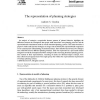Free Online Productivity Tools
i2Speak
i2Symbol
i2OCR
iTex2Img
iWeb2Print
iWeb2Shot
i2Type
iPdf2Split
iPdf2Merge
i2Bopomofo
i2Arabic
i2Style
i2Image
i2PDF
iLatex2Rtf
Sci2ools
AI
2004
Springer
2004
Springer
The representation of planning strategies
sis of strategies, recognizable abstract patterns of planned behavior, highlights the difference between the assumptions that people make about their own planning processes and the representational commitments made in current automated planning systems. This article describes a project to collect and represent strategies on a large scale to identify the representational components of our commonsense understanding of intentional action. Three hundred and seventy-two strategies were collected from ten different planning domains. Each was represented in a pre-formal manner designed to reveal the assumptions that these strategies make concerning the human planning process. The contents of these representations, consisting of nearly one thousand unique concepts, were then collected and organized into forty-eight groups that outline the representational requirements of strategic planning systems. 2003 Elsevier B.V. All rights reserved.
| Added | 16 Dec 2010 |
| Updated | 16 Dec 2010 |
| Type | Journal |
| Year | 2004 |
| Where | AI |
| Authors | Andrew S. Gordon |
Comments (0)

